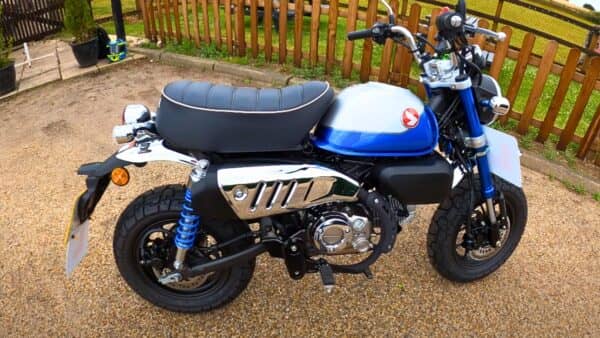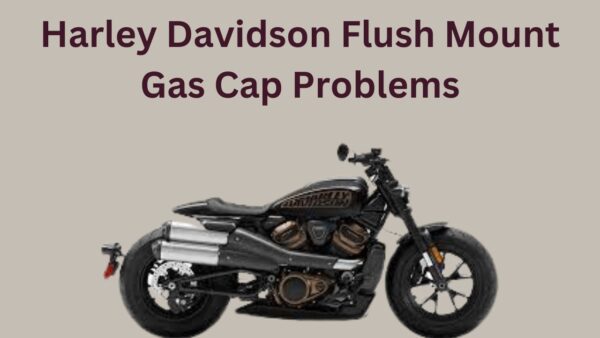The Honda Monkey 125 is a charming nod to the past, bringing the classic Z-series’ retro style into the modern era with enthusiasm and a smile.

However, even the most delightful motorcycles are not without their issues. Owners and potential buyers should be aware of the common problems.
In this article, we will dive into these issues to provide enthusiasts and prospective owners with an understanding of what to anticipate.
Honda Monkey 125 Problems
Riders have reported problems with the bike’s comfort over long distances, citing its compact ergonomics and firm seat as factors that can lead to discomfort.

However, the Monkey’s suspension, while suitable for urban rides, may not absorb larger bumps and potholes as effectively as one would want.
Some owners have also mentioned limitations in aftermarket parts compared to more mainstream models, which can restrict customization options.
1. Starting Issues
One of the most common issues that some riders have reported concerns difficulty in starting the motorcycle, particularly when the engine is cold.
This problem can be attributed to various factors ranging from the battery’s health, the quality of the fuel used, the spark plug condition, or even the EFI system.
To troubleshoot this issue, the starting issue would begin by examining the battery, ensuring it is fully charged and in good working condition.
If the battery checks out, the next step would be to inspect the fuel system; stale fuel can clog the injectors and prevent the engine from firing.
Replacing old fuel with fresh, high-quality fuel can often resolve this problem.
However, checking and replacing the spark plug if it is fouled or damaged can help, as a good spark is essential for ignition.
Lastly, the EFI system may require a diagnostic check to ensure sensors and electronic components are functioning correctly.
If you’re experiencing persistent issues despite these troubleshooting steps, consider consulting a professional mechanic, as there could be a more complex underlying issue.
2. Electrical Problems
Most owners have reported encountering various electrical problems that can range from minor inconveniences to issues.
Common complaints involve malfunctioning indicators, ignition troubles, and battery drain issues.
To address these, a thorough inspection process is required, starting with checking fuses and wiring connections for signs of wear or corrosion that could disrupt the electrical circuit.
If the indicators are not functioning, it’s essential to check the bulbs and the connections to the indicator relay.
For ignition issues, ensure that the battery terminals are clean and secure; if the problem persists, the starter motor and ignition switch should be examined.
If you’re experiencing battery drain, it is necessary to perform a parasitic draw test with a multimeter to identify if there is an unwarranted power draw when the bike is off.
3. Fuel System Issues
Fuel system issues are a prevalent concern among Monkey 125 owners, stemming chiefly from fuel contamination and carburetor complications.
The problem typically presents as difficulty in starting the engine, inconsistent throttle response, or sudden stalling during operation.
This can largely be attributed to clogged fuel injectors, a result of impurities in the fuel, or a build-up of residue over time.
To address this challenge, starting with fuel quality checks, ensuring fresh and high-quality gasoline is used to prevent impurities from clogging the system.
Related: Honda Navi Vs Honda Monkey – Which is Best
Following this, a thorough inspection and cleaning of the carburetor and fuel injectors should be undertaken.
However, replacing fuel filters at regular intervals is essential to safeguard against contaminants entering the engine.
In cases where troubleshooting the fuel system does not resolve the issue, it may be necessary to dive deeper to examine the fuel pump and pressure regulators, which can also affect the motorcycle’s performance.
Each of these components plays a critical role in the seamless delivery of fuel to the engine, and any faults within this system can disrupt the intricate balance required for optimum engine function.
4. Transmission Problem
However, numerous owners have reported a concerning issue regarding the bike’s transmission.
Specifically, there have been instances of gear slippage, difficulty in shifting, and an uncomfortably notchy feel when moving between gears.
This problem is often attributed to a manufacturing defect within the gearbox or a misalignment of the transmission components.
To resolve the issue you should have a thorough inspection of the shift linkage for wear and proper lubrication.
If the problem persists, inspecting the clutch assembly and gear synchronizers is necessary, as these components are fundamental to smooth gear transitions.
In some cases, a complete gearbox overhaul may be required to address these failures effectively.
5. Overheating
Some owners have reported issues with engine overheating, which is a significant concern, especially during extended rides or on hotter days.
Overheating can be attributed to core reasons such as inadequate coolant levels, a malfunctioning radiator fan, or blockages within the cooling system.
To prevent your bike from overheating, ensure that the coolant is filled to the proper level and is replaced per the maintenance schedule.
The radiator fan should operate correctly; if not, it may require a check for electrical issues or a potential replacement.
Also, routinely inspect the radiator for blockages and clean the exterior fins to ensure optimal heat dissipation.
If overheating persists, it’s advised to consult a professional mechanic or a Honda service center for a thorough diagnostic check-up and remedy.

Ahtsham Younas is a passionate blogger and content writer. He loves to ride motorcycles and learn the mechanical process behind the motorcycles.
He has been writing articles in the motorcycle industry since 2019 and has learned many things about motorbike niches.


